Archive for May, 2011
Blueberry French Toast Casserole
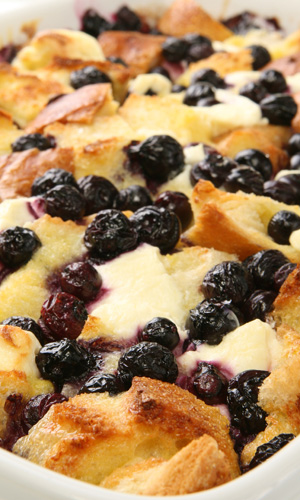
This coming month will be a busy time for our little homestead. Not only has spring finally arrived with all the chores and planting that goes along with its warmer weather, but a bounty of garden tours, workshops, lectures, festivals and gatherings are planned. Each weekend will be an opportunity to meet new friends, catch up with old ones and to show off what the season has to offer with a colorful array of potluck dishes. I love these kinds of gatherings, elegant and simple, yet unpretentious, with lots of time spent in gardens bursting with color and a peak at things to come. It’s a great way to shake off what has been an unpredictable winter that lasted weeks longer than normal.
It’s prime blueberry season in our neck of the woods and there’s nothing better than a weekend brunch marked by blueberries bursting with flavor. And the compliments for arriving with a clever dish that catches people’s eye and has them asking, “Can I get the recipe” ain’t bad either.
I came across a recipe for Blueberry French Toast Casserole and with a few adjustments it’s too wonderful and yummy to keep to myself. Here’s how you can make your own splash at a weekend brunch and have them coming back for more:
Blueberry French Toast Casserole
12 slices egg bread or Brioche, cut into 1-inch cubes
16 oz. cream cheese, softened
2 cups fresh local organic blueberries
12 farm fresh eggs
2 cups whole organic milk
1/3 cup pure Vermont maple syrup
1. Butter a 9”x13” baking dish.
2. Cut or tear bread into ½” cubes, spreading half the bread in the baking dish.
3. Cut cream cheese into 1” cubes and layer over bread. Top with blueberries and remaining bread.
4. In a large bowl, mix together eggs, milk and syrup. Pour mixture over layered bread. Use a spatula to press bread down into liquid.
5. Cover pan with foil and refrigerate for 8 hours or overnight. Set on counter 30 minutes before cooking. Preheat oven to 350F.
6. Bake for 45 minutes. Uncover and bake until top is golden brown and egg mixture is set in the middle, about 25-30 minutes more. Use a knife to check.
To make this dish even more decadent, serve it with a bit of Blueberry Sauce, which can be made while the casserole is baking.
Simply combine ½ cup sugar and a tablespoon of corn starch in a small saucepan. Add to it ½ cup of water and boil for 3 minutes. Then add ½ cup of fresh local organic blueberries and simmer until the berries begin to burst. This will take about 8 to 10 minutes. Take pan off the stove and stir in one teaspoon of nutmeg.
To serve your blueberry dream, cut into squares or spoon out portions onto a plate and drizzle blueberry sauce over the top. You can even add a shake or two of powered sugar.
Feeling a little adventurous with the coming of summer? Try making this casserole with other summer time berries like strawberries, blackberries, Olallieberries, or Logan berries.
![]() photo credit: Florida Magazine
photo credit: Florida Magazine
A Homesteaders Dozen
12 weeks before State Fair
11 vegetable beds ready to plant
10 yellow raspberries potted and ready to sell
9 pints of blackberry jam made
8 new chicks in the brooder
7 friends spending time at the beach
6 pounds of pork shoulder turned into sausage
5 dozen farm fresh eggs sold today
4 market lambs gaining steadily
3 roosters processed and made into soup base
2 farm dogs lazing around
1 gosling growing fat
0 complaints on this beautiful spring day
Did You Know… A baker’s dozen is (maybe) 13, but a shepherds dozen is 11.
What Are The Bees Telling Us?
QUEEN OF THE SUN: What Are the Bees Telling Us? is a profound, alternative look at the global bee crisis from Taggart Siegel, director of THE REAL DIRT ON FARMER JOHN.
Siegel takes the viewer on a journey through the catastrophic disappearance of bees and the mysterious world of the beehive, this engaging and ultimately uplifting film weaves an unusual and dramatic story of the heartfelt struggles of beekeepers, scientists and philosophers from around the world including Michael Pollan, Gunther Hauk and Vandana Shiva. Together they reveal both the problems and the solutions in renewing a culture in balance with nature.
To visit the official website for Queen of the Sun click here.
Vegetable Water Does Double Duty
When I was growing up my mom never boiled vegetables because, as she said, “the best part of the vegetable is lost”.
What she meant was the vitamins and nutrients were lost in the boiling water. As I got older and became more aware and educated about organic gardening I also began to wonder if the nutrients in water used to boil potatoes and beets or the water used to steam many of our other veggies couldn’t be used on my plants.
As an experiment I would cool a pot of vegetable water then use it to water my garden. After some time I began to notice how green and lush my plants were becoming.
Now, I never throw a pot of water down the drain, but rather cool it for watering my plants, both potted and ground planted. From pots of boiled potatoes and pasta to steamed vegetables to canning, the water I use throughout the day is doing double duty—cooking and providing a nourishing drink for my plants.
And, the fact that I save a little on my water bill is just an added bonus.
The Real Dirt on Farmer John
THE REAL DIRT ON FARMER JOHN follows Farmer John’s astonishing journey from farm boy to counter-culture rebel to the son who almost lost the family farm to a beacon of today’s booming organic farming movement and founder of one of the nation’s largest Community Supported Agriculture (CSA) farms. The result is a tale that ebbs and flows with the fortunes of the soil and revealingly mirrors the changing American times.
Make Your Own Honey Cow
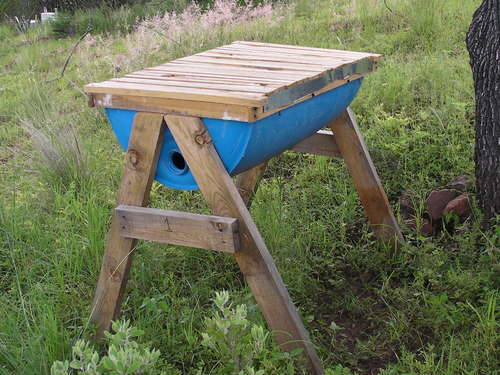
Beekeeping is an art form that dates back thousands of years. It was a DIY project undertaken by both farm families and commercial enterprises. It is said that one hive will produce enough honey to supply a family for one year with enough left over to sell. That’s why small honey production has been a staple on small farms or homesteads for centuries.
Anyone can produce honey at home. Many different kinds of hives can be used. But, for the suburban homesteader city ordinances and zoning codes could be your biggest hurdle so check those out first. If you are lucky enough to be able to house a hive check out this inexpensive and simple design called the Honey Cow by Instructables.com
The Honey Cow is designed to mimic nature as much as possible. Unlike commercial hives that have frames, a foundation or excluders the Honey Cow only has top bars, allowing the bees to do naturally what they would do in a fallen log: build beautiful, natural combs.
It’s easy to make and manage, which makes it perfect for the beginner beekeeper. Plus it’s less intrusive to the bees.
To make your own Honey Cow check out the step-by-step instructions at instructables.com
Homemade Seed Tape
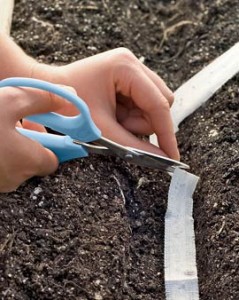
Some seeds are so small and hard to handle that you end up wasting more than you plant, or planting them so close that they need to be thinned heavily. But, it doesn’t have to be that way anymore. You can make you own homemade seed tape with toilet paper and a little bit of honey. The homemade version works just as well as the commercial ones for a lot less money.
Here’s how to make them.
1.) Start with a strip of toilet paper the length of the row you want to plant. If that is too long lengths of 12 to 18-inches is very workable and useable in a garden bed. Spread the toilet paper out flat being careful not to tear it then fold it in half length-wise. After you have creased the TP it can be unfolded to lay flat. Single or double-ply will work, but the single-ply works best because smaller seeds can root through the single layer, plus it decomposes faster. Also try to avoid scented and colored TP as it only adds chemicals to the soil.
2.) Mix about a teaspoon of honey with several drops of warm water to thin it out. The number of seed strips you are making will determine how much honey you will need. Using a small spoon, popsicle stick or paint brush gently spread a thin layer of the honey mixture down the middle of one of the folded sides of TP. Be careful not to press too hard or you will tear the TP.
3.) Before the honey dries, sprinkle an evenly spaced row of seeds down the line of honey. Check each seed packet for the recommended seed spacing. If shaking seeds out of the packet proves too difficult simply pour them into your hand or into a small bowl and place them one at a time onto the TP.
4.) Now fold the unseeded edge of the tape onto the seeded side and gently press so the honey can “glue” the two sides together. The long continuous line of honey will help keep the seeds from slipping out of place.
5.) Using a fine pen gently write the seed name, plant height, row spacing and date seed tape was made onto one edge of the seed tape. Be careful not to tear the tape. Including the plant height and row spacing will help when laying out your garden bed.
6.) After preparing the garden bed lay seed tape in desired location. Cover tape with a light peat moss mixture to the depth recommended on the seed packet. Water and keep moist as with direct sown seeds, especially after seeds have sprouted. The toilet paper tape will protect seeds from birds and small animals and from being blown away by the wind or washed away by rain or sprinklers.
The toilet paper quickly and easily decomposes never to be seen again and what remains is a perfectly laid out garden bed.
![]() photo credit: Minneapolis.Metblogs
photo credit: Minneapolis.Metblogs

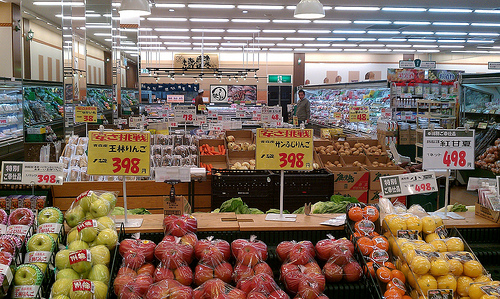

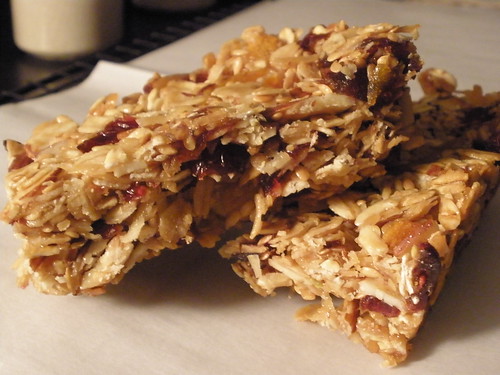
Recent comments
Aenean nonummy hendrerit mauris. Phasellus porta.